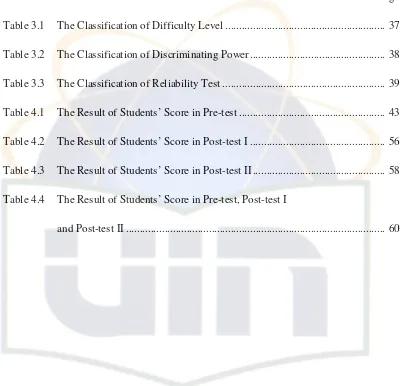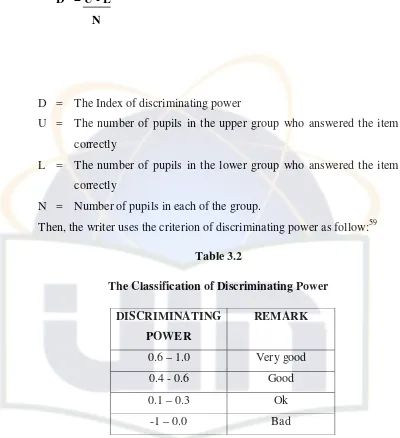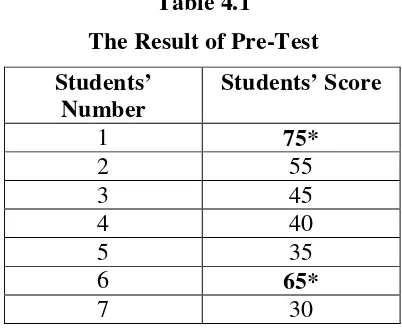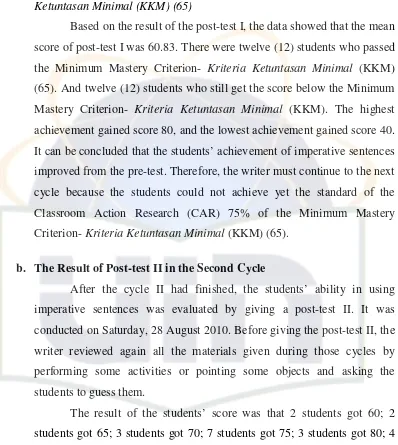I. Introduction
This section provides the background of the study, highlighting the importance of English as an international language and the challenges faced by Indonesian students in learning imperative sentences. The researcher notes observations from MTs Islamiyah Sawangan indicating students struggle with vocabulary, verb usage in prohibitions, and interpreting signs. The current deductive teaching method, presenting rules before examples, is identified as contributing to student boredom and passive learning. The study proposes using Total Physical Response (TPR) as a solution, aiming to improve students' ability in using imperative sentences by connecting language with physical actions. This introduction effectively sets the stage for the research, establishing the context and rationale for the chosen methodology.
1.1 Background of the Study
This subsection emphasizes the significance of English language acquisition in the globalized world, particularly for Indonesian students. It highlights the challenges specific to imperative sentence learning, such as limited vocabulary, confusion in verb usage (especially in prohibitions), and difficulty interpreting visual cues (signs). The researcher observes a deductive teaching approach currently in use, noting its shortcomings in student engagement and retention. The introduction of TPR as a potential solution is logically justified, framing it as a method that bridges the gap between language comprehension and physical activity, thereby enhancing learning.
1.2 Problem Identification
This subsection clearly outlines the key research questions, focusing on the effectiveness of TPR in improving students' performance in using imperative sentences. The central question, "How does the Total Physical Response develop student’s ability in using imperative sentences?", is explicitly stated and forms the core of the investigation. The other related problems are also mentioned, providing a broader perspective while maintaining a clear focus on the primary research objective. This section demonstrates a systematic approach to problem definition, crucial for a research-based article.
1.3 Limitations and Formulation of the Problem
This section clearly defines the scope of the research, specifying that the study focuses solely on the application of TPR to enhance imperative sentence usage among seventh-grade students at MTs Islamiyah Sawangan during the 2010/2011 academic year. The central research question, concerning the effectiveness of TPR in developing students’ ability to utilize imperative sentences, is formally presented. By explicitly stating limitations and framing the research question, this subsection contributes to the rigor and clarity of the study's design. This careful delineation of the scope is essential for ensuring the feasibility and focus of the research.
1.4 Objectives and Significance of the Study
The objectives clearly state the aim of evaluating the teaching-learning process of imperative sentences using TPR. The significance is articulated by outlining the expected benefits for three key stakeholders: teachers (enhanced knowledge of TPR), students (improved skills in imperative sentence usage and overall English proficiency), and future researchers (providing insights for future studies). This subsection effectively connects the research to its potential practical impact, strengthening its academic relevance and justifying its contribution to the field of English language teaching.
1.5 Organization of Writing
This subsection provides a concise overview of the entire research paper’s structure, outlining the content of each chapter. This serves as a useful roadmap for the reader, allowing them to quickly grasp the flow of the argument and the logical progression of the research. The clear structure enhances readability and comprehension, making the research accessible to a broader audience. This section emphasizes the logical and organized presentation of the research findings.
II. Theoretical Framework
This chapter presents the theoretical underpinnings of the study. It defines imperative sentences, detailing their forms and various uses (commands, requests, suggestions, etc.). The chapter then introduces Total Physical Response (TPR), providing a comprehensive definition, outlining its design elements (objectives, syllabus, teacher's and learner's roles, activities), and explaining its principles. The advantages and disadvantages of TPR are also discussed, followed by a review of relevant studies and the formulation of a conceptual framework and hypothesis for the action research. This section demonstrates a thorough grounding in relevant theories and provides a strong theoretical framework for the study.
2.1 Imperative Sentences
This subsection offers a detailed examination of imperative sentences, encompassing their definition, various forms (affirmative, negative, emphatic), and diverse functions within communication. It distinguishes between different types of commands and explores the nuances of politeness and formality in requests. The review of existing grammatical frameworks provides a solid foundation for understanding the target grammatical structure being taught, establishing a clear theoretical base for the research. Different perspectives on imperative sentence structure and use are integrated to form a comprehensive analysis.
2.2 Total Physical Response (TPR)
This subsection provides a thorough explanation of TPR, including its definition, origins, and underlying principles. It details the method's design aspects, specifying the teacher's and learner's roles and outlining the typical activities involved. A discussion of TPR's advantages and limitations offers a balanced perspective, informing the reader of the potential benefits and drawbacks of employing this approach. This comprehensive overview lays the groundwork for understanding how TPR will be applied in the classroom action research.
2.3 Relevant Studies, Conceptual Development, and Action Hypothesis
This section integrates relevant prior research to provide context and support for the current study. It details how the theoretical frameworks of imperative sentences and TPR inform the research design. A clear action hypothesis is then presented, stating the expected outcome of the classroom intervention using TPR. The inclusion of prior research strengthens the study's credibility and places it within the broader academic conversation. The articulation of the action hypothesis provides a clear, testable prediction, guiding the analysis and interpretation of the results.
III. Research Methodology
This chapter describes the research design and methods employed in the classroom action research (CAR). It specifies the time and place of the study, the participants (students), the data collection methods (pre- and post-tests, interviews, observations, field notes), and the data analysis techniques used to assess the effectiveness of TPR in teaching imperative sentences. The trustworthiness and success criteria of the CAR are also defined. This section explains the procedures used to gather and analyze data, ensuring the study’s transparency and replicability.
3.1 Research Design and Context
This subsection details the chosen research methodology (classroom action research) and clearly defines the setting (MTs Islamiyah Sawangan), the timeframe, and the specific group of students involved. It provides a description of the research design, outlining the steps involved in the cyclical process of planning, acting, observing, and reflecting. The context provided ensures the reader understands the specific environment in which the research is taking place, thus enhancing the overall understanding of the research process and its findings.
3.2 Data Collection and Analysis
This subsection elaborates on the methods used to gather data, explaining the use of pre- and post-tests to measure student performance, as well as the use of interviews, observations, and field notes to gather qualitative data. It also describes how the data will be analyzed, ensuring transparency and providing the reader with a complete understanding of how the research findings will be derived. The explanation of both qualitative and quantitative data collection and analysis methods shows a commitment to using a mixed-methods approach to gather a more comprehensive understanding of the impact of TPR.
3.3 Trustworthiness and Success Criteria
This subsection outlines the measures taken to ensure the credibility and reliability of the research findings, focusing on elements of trustworthiness in qualitative research and outlining the criteria used to determine the success of the intervention. This section demonstrates an understanding of the need for methodological rigor, even in a classroom-based study. Defining success criteria in advance provides a clear benchmark against which to evaluate the impact of the intervention and ensures objectivity in interpreting results.
IV. Research Findings
This chapter presents the results of the classroom action research, detailing the data collected before, during, and after the implementation of TPR. It presents the findings from pre-observation, pre-interview, and pre-test, followed by a detailed account of the implementation of the two cycles of the action research, including planning, acting, observing, and reflecting phases. The data analysis includes post-interview, field notes, and post-test results. The interpretation of test results is presented, showing the impact of TPR on students’ ability to use imperative sentences. This section presents the collected data in a structured manner, allowing for a clear evaluation of the effectiveness of the TPR methodology.
4.1 Pre-Implementation Data
This subsection presents the baseline data collected before the implementation of TPR, including the results of pre-observations, pre-interviews, and pre-tests. This establishes a benchmark against which to compare the changes observed after the intervention. Presenting this baseline data is crucial for demonstrating the effect of the intervention, providing a clear picture of the initial state of students' understanding and skills.
4.2 Implementation of Cycles 1 and 2
This subsection details the implementation of the two cycles of classroom action research. It describes the planning, acting, observing, and reflecting stages of each cycle, providing a detailed account of the instructional activities and the teacher's adaptations based on observations and reflections. This detailed account enhances the study's trustworthiness and replicability, enabling other researchers to understand the practical steps taken during the intervention.
4.3 Post-Implementation Data Analysis and Interpretation
This subsection analyzes the data collected after the implementation of TPR, including post-interviews, field notes, and post-test results. It presents a comparative analysis of the data from pre- and post-tests, showing the improvement in students' performance. The interpretation of the data is presented, linking the findings back to the theoretical framework and research questions. This section combines qualitative and quantitative data analysis, offering a comprehensive evaluation of the effectiveness of TPR in the specific context of the research.
V. Conclusion and Suggestion
This chapter summarizes the key findings of the study, drawing conclusions on the effectiveness of TPR in developing students' ability to use imperative sentences. Based on the findings, the researcher provides suggestions for teachers, future researchers, and curriculum developers. This section effectively summarizes the research findings and their implications, providing concrete recommendations for practical application and future research directions.
5.1 Conclusion
This section summarizes the main findings of the research, restating the central conclusion regarding the effectiveness of TPR in improving students' use of imperative sentences. This concise summary reiterates the key results and their implications, providing a clear and accessible conclusion for the reader. It links the findings back to the research questions and the initial observations, effectively closing the argumentative loop.
5.2 Suggestions
This subsection offers practical recommendations for teachers on how to integrate TPR into their English language teaching, particularly when focusing on imperative sentences. It also suggests areas for future research, expanding on the scope of the current study or exploring related topics. Finally, it may offer suggestions for curriculum developers on incorporating TPR into English language curricula. This section emphasizes the practical application of the findings and outlines avenues for future research, contributing to the broader field of language pedagogy.









